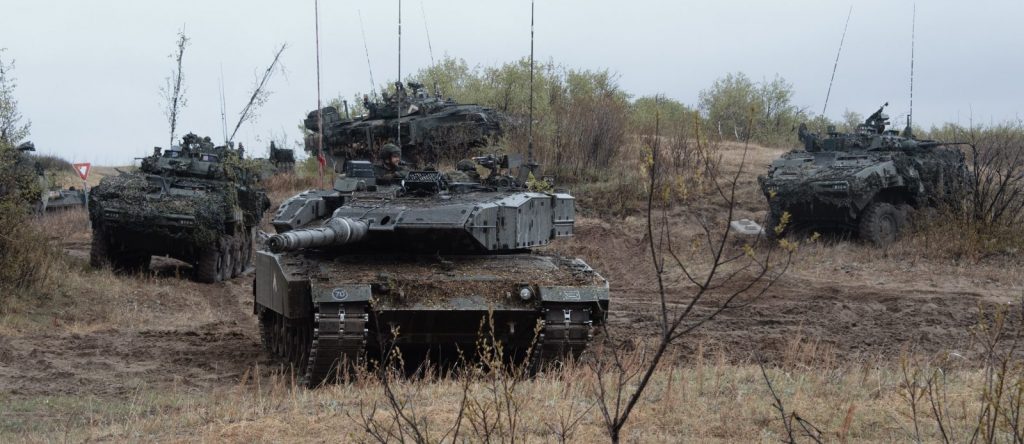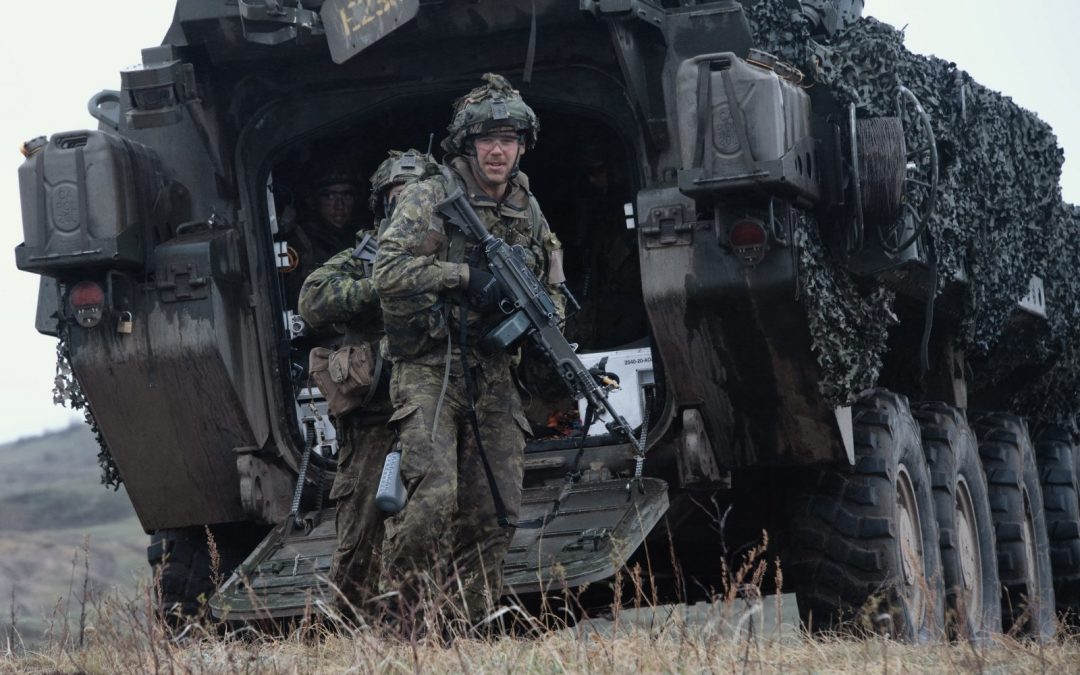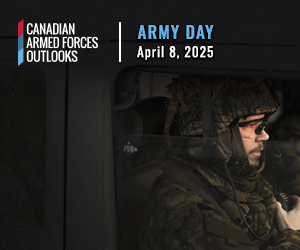by Kevin Wang and HengLiang Wu
Combat results in the last decade indicate that an appropriate amount of time should be made available for combined arms training, especially for those who do not have experience in this regard. As the recent Nagorno-Karabakh War has demonstrated, combined arms operations under good execution are always more effective than single arm operations.
Yet, with only one night per week and one weekend per month, scheduled training time is very limited for Reserve officers. Therefore, planning, coordinating, and executing capabilities should be the training aim of Reserve officers.
In the post-war years, the lethality of combined arms operations has rapidly increased with the improving accuracy and power of modern weaponry. Examples in the Gulf War have shown that, when aerial protection is not guaranteed, all that is required to eliminate battalions of tanks are a handful of helicopters and fixed-winged aircraft. Of course, the concept of combined arms operations is not constrained to land warfare. The losses of HMS Coventry and HMS Sheffield in the Falkland’s War show that it is much the same at sea. Both ships were capable destroyers on radar picket duty when sunk at exposed positions. The failure of continuous air cover on the part of the British task force gave the Argentines opportunities to sink the ships, leading to tragic consequences.
These examples show that mastery of combined arms is no less important than competency at individual stations. It is imperative that the idea is well understood at every level of command.
The mastery of the combined arms principle has expanded as new domains of warfare have come into effect, from cyberwarfare to space-based intelligence capabilities. These have imposed higher demands on the command staff to process increased amounts of intelligence and to coordinate operations in each domain.
There should be no illusions: The learning curve to meet this demand is steep and requires continuous effort over sufficient time to develop the necessary skill. Training with regards to these capabilities is largely neglected for Reservists and could prove fatal in a war against a structured and well-armed enemy.
Modern combat requires fast responses, and the responsibilities of coordination and initiative are transferred to some extent from a centralized command to each component unit. This means the regimental commanding officer cannot be the only person with the skillset to coordinate operations among friendly assets – every officer should be able to do so.

Members of Canadian Army conduct a combined arms attack at 3rd Canadian Division Support Base (3 CDSB) det Wainwright’s training area during Exercise MAPLE RESOLVE 2019. Photo: Cpl Djalma Vuong-De Ramos
We believe that the introduction of regular joint exercises between local Reserve units and the development of a battlespace simulation software intended for Reservists’ use can remedy the current training deficiency. For instance, combat and support units based around Vancouver, including the Seaforth Highlanders, 15th Field Artillery Regiment, the British Columbia Regiment, the 39th Signal Regiment and the 39th Service Battalion can organize a joint exercise once a year to test their interoperability. If possible, involvement of air and naval assets would increase the realism of the exercise. In essence, Reserve units should be encouraged to hold their own “mini-Exercise Maple Resolve.”
On the other hand, the battlespace simulation software developed should support map-based wargaming of hypothetical scenarios and hence provide proof of concept and theoretical backing for combined arms exercise plans. The simulation process could include optional battle domains, such as electronic warfare, that are not normally explored. Some commercial options provide good starting points, such as Command Modern Operations on Steam.
Reservists will command units in the form of operation debriefs and the training software should include weapon systems available to the CAF. The simulation should be run by two opposing teams while requiring very few or no umpires.
It is imperative that before engaging in a battlespace simulation, teams prepare staff plans encompassing as much detail as possible. The goals of battlespace simulations are to develop in Reservists the ability to “foresee” the progression of an operation and to learn potential shortcomings at the planning stage which could cause mission failure.
The first goal is supportive of regular field exercises. It should be expected that eventually Reservists will be able to visualize the battlespace given limited intelligence and to make appropriate adjustments accordingly in real time in a field operation.
The second goal is integral to the training to staff officers whose responsibility is to ensure mission success by planning and elimination of variables and threats. The simulation can provide experience in the training regime.
The above two additions to training should be sufficient to enhance understanding and execution of the combined arms concept among Reserve officers.
As the Canadian Armed Forces struggles to maintain its current strength while preparing for the next generation of warfare, Reservists will be expected to be as competent as Regular Force members. Their interoperability should hence be guaranteed by advanced combined arms simulation and exercise experience. Only in this way can the combat effectiveness of the force be maintained.
Kevin Wang is studying at Imperial College London in the United Kingdom. HengLiang Wu is studying at Western University.




There are, as always, more than a couple of issues in Training.
INDIVIDUAL SKILLS:
These personal skills can be worked on and improved with minimal resources. There is no need for these to be 100% prior to collective training. It never is in the Reg. Force if one is honest.
LEADERSHIP SKILLS:
These are essential, but there is a need for stripping Reserve Training of some of the “Nice to have” aspects so that they are Trained, Experienced, and Tested on the essentials for the level of Command.
SANDBOXING:
These are important for the development of the mental abilities of the Leadership (Officers) and Support (NCOs) at the level being Trained. Whether on a physical or electronically simulated gaming board there must be the ability to be able to view the simulated terrain from a birds-eye view to correlate it to the Map view. These allow for the mental development of the assessment, planning and staff duties at the various levels. It is important for the participants to be co-located as much as possible, so that they can consult and observe not only the various team approaches but the interactions of those team members. The human interaction aspect is important so that Plans and Planning doesn’t become tunnel-visioned.
TEWTS:
These enhance Sandboxing as the provide the opportunity to read the terrain from the horizontal perspective and relate it to the Map View. Real World v. Map World. It allows the participants to “get in the mood”, by living on the ground, and feeling a portion of the fatigue and inclement conditions while working through the mental processes, all while avoiding jerking around the Troops and the reduced costs. Personalities and approaches can’t be safely observed and assessed.
COLLECTIVE TRAINING:
This is the beginning of the “Rubber Hitting the Road”. People are part of plans, and the ability to read, train and motivate the Troops at any Command Level. Work-Ups need to progress through Section, Platoon, Company, to Battalion Level.
INTEROPERABILITY TRAINING:
This commences to some degree as the formations increase in size and complexity.
PRODUCT v. PROCESS:
There is no need for perfection of the “Product” at the various levels of Training. It is the “Process” that must be grasped and exercised for those levels. If the Process is strong, the Product will perfect itself through repetition of the experience. Think of Hockey Team Training. Where it is the combination of working on individual skills, squad drills, team drills for “Plays”, and inter-squad games for the practical testing, and finally the Game itself.
CONSIDERATIONS:
1. TEAM COMPOSITION: The team composition will always be in the process of change and renewal, from Recruit to Retirement, so it will always be a mixed bag.
2. HUMAN ASPECT: Remote Training is OK for Technical Tidbits, but it is people and personalities that make it a success, …., or a failure. We forget that aspect of a training, at our peril.
3. WANT v. NEED: The importance of Training, Reserve or Regular, is firstly about imparting the knowledge & skillset to be able to operate at that level. For Reservists, while it is always desirable for them to have the opportunity to be Trained on Reg Force Courses Or employed for periods of time in those Units, the reality of Civilian Employment is often the limiting factor. Reserve Training must be trimmed towards the essentials. Larger Formation Training needs to be progressively worked towards so that the increasing complexity can be absorbed. The Americans at one time had established METL (Mission Essential Task Lists) to determine when it was appropriate for a Unit to be considered effective for progressing to inclusion in the next higher formation.
4. EFFECTIVENESS v. PERFECTION: While Perfection is an admirable goal, it is elusive, but cannot be allowed to impede the effectiveness of operation at the next higher level. Both the Reg. Force and Reserves are staffed by people, motivated people, all striving for advancement the the next level in their leagues, and when deployment is required must be capable of working together, with a period of adjustment for both elements.
5. TIME IN TRAINING: Collective Training should have sufficient time for gathering in bivouac and working out individual and smaller Unit kinks, followed by the Tactical Exercise. With a 2 Week Annual FTX, it usually consists of a 1 Week Bivouac, and 1 Week Tactical Exercise. A 1 Week and 2 Week would likely be preferable, but “Time is the Enemy”, and whether Employers can be convinced or Legislated to grant it. It has often been seen by the Leadership that Legislation would be a “Two Edged Sword”, as a rationale for not pursuing it, leaving the Reservist with “All Scabbard, No Sword”.
Just some rambling thoughts from a LRR (Long Retired Reservist).
CWO (Ret’d) Gwyn “Nick” Nicholson.
I agree entirely. I have often felt that there should be a collective ex for Reserve units in the same area.